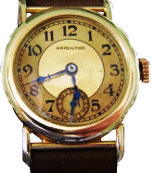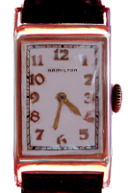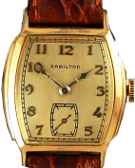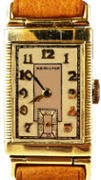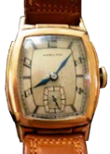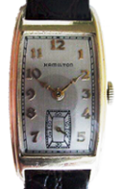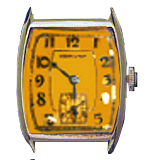By 1936, the government began publishing economic information that said the country had regained levels of late 1920’s prosperity. They didn’t mention unemployment, which remained high.
1936 began a prelude to a major recession that peaked in 1937. the American economy unexpectedly fell, lasting through most of 1938. Production declined, as did profits and employment. Unemployment jumped from 14.3% in 1937 to 19.0% in 1938. A contributing factor to the Recession of 1937 was a tightening of monetary policy by the Federal Reserve. The Federal Reserve doubled bank reserve requirements between August 1936 and May 1937 leading to a contraction in the money supply. Take money out of an economy, credit gets tight and businesses fail.
Management at the Lancaster, Pennsylvania watch company took a cautious approach to the market. Hamilton continued its diversified approach to the market by selling movements, making parts for other manufacturers and holding market share as the premiere wristwatch. They also continued making improvements to their highly regarded railroad timepieces.
Hamilton released eight new watches to its line of men’s wristwatches (seven of which are shown below):
|
|
|
||||||
|
|
|
||||||
|
The Randolph is the rarest round case wristwatch made by any one of the major manufacturers during the Depression. Production lasted one year only as Hamilton changed its market strategy as the economy began to take a turn downward. The Randolph is a small watch similar to the 1927 wristwatches for women with a 28 mm diameter. This is a museum quality timepiece.
Hamilton introduced the Norfolk in 1936. They only made one men’s watch with the 989E movement – 18/0 size ladies movement with 17 jewels. The Norfolk sold for a little over other Hamilton 10K gold filled wristwatches of the time.
It initiated the concept of the American tank style watch. The style didn’t die with the Norfolk. The company’s earlier success with their Explorer Series led them to experiment until they settled on a 14/0 movement, which changed the landscape of watch styles for the next four decades.
Hamilton’s low-end product line included the Morley. If you wonder why 987 movements came in 10K gold-filled cases after 1936, then the Morley is a good example. Hamilton’s popular-priced strap watches contained the reliable 987, 17 jewel movement. The company targeted individuals who could not afford a Hamilton and the low content gold-filled cases helped Hamilton create lower priced watches.
The Pierre began a new generation of 982 19-jewel movements. It became the first 982 wrist watch manufactured with hinged lugs. It came in 14K solid gold. Hamilton produced this model to compete with Gruen.
The Pierre did not achieve popularity when first introduced and the company produced it for only two years. The Pierre is a very scarce model and is sought by collectors.
The Lawrence fell into the category of the new line “lower” priced models. The 1936 Catalog advertised this line as “Hamilton’s popular-priced strap watches” all of which had the 987 17 jewel movement. The company marketed these watches to individuals who previously could not afford to own a Hamilton and the model line was available in gold-filled cases only.
The Clark became a popular watch when introduced and was the second generation to utilize Hamilton’s 17-jewel 980 movement. At the time of introduction, the Clark was Hamilton’s longest wristwatch and it was curved to fit the wrist.
The Clark is often confused with the Yorktowne which was introduced in 1940. Each utilize the same Wadsworth case only the Clark case is 14K gold-filled while the Yorktowne case is 10K gold-filled.
The Watson was made in yellow gold filled only and offered in two dial variations – applied gold numeral dial or with gold finish black numeral dial as shown. The gold finish black numeral dial as pictured above is the scarcer of the two offerings. Hamilton released the Watson as part of their low-end models believing demand for such products would increase in 1936. The Watson had a 10K gold-filled case. The company released it along with the Dixon, Drake, Lawrence, Mason, Morley, Scott and Turner.
The Economic reality of 1936 differed from newspaper accounts.
 The population of Hoovervilles (homeless people with makeshift shelters) increased. People lived in cardboard boxes, tents, and wooden sheds they built.
The population of Hoovervilles (homeless people with makeshift shelters) increased. People lived in cardboard boxes, tents, and wooden sheds they built.
Charles Michelson, publicity chief of the Democratic National Committee, came up with the name Hooverville. He aimed it as a reference President Herbert Hoover who the Democrats blamed for the depression. Democrats also came up with other terms such as the “Hoover blanket” (old newspaper used as blanketing) and “Hoover flag” (an empty pocket turned inside out). They called cardboard used to line a shoe as “Hoover leather”. People called automobiles drawn by horse, “Hoover wagons”.
In 1936, people many people begged for food or went to soup kitchens.
Police would remove occupants of Hoovervilles for technically trespassing on private lands, but eventually Americans tolerated them out of necessity.
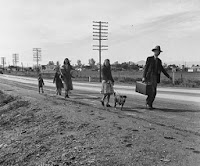 The most devastating phenomenon of 1936 was the Dust Bowl where unlivable conditions began a migration out of the Midwest. The migration started in 1935 and peaked between 1937 and 1938. Families from Oklahoma and neighboring states traveled along desert roads to California. John Steinbeck’s 1939 novel, The Grapes of Wrath, depicted life during the Dust Bowl.
The most devastating phenomenon of 1936 was the Dust Bowl where unlivable conditions began a migration out of the Midwest. The migration started in 1935 and peaked between 1937 and 1938. Families from Oklahoma and neighboring states traveled along desert roads to California. John Steinbeck’s 1939 novel, The Grapes of Wrath, depicted life during the Dust Bowl.
Other Events of 1936
- A Tupelo Mississippi tornado killed 216 and annihilated the city
- Another Tornado killed 203 and injured 1,800 in Gainesville Georgia
- Anti-Jewish riots broke out in Palestine as Hitler began exporting Jews to Palestine
- The Remington Rand strike, led by the American Federation of Labor, began
- The Nazi Oranienburg Concentration Camp opened
- Gen Francisco Franco led an uprising and started Spanish Civil War
- Chinese leader Chiang Kai-shek declared war on Japan
- United Auto Workers staged the first sit-down strike at the Fisher Body Plant
- The U.S. government sponsored a repatriation of “illegal immigrants” and sent 400,000 people to Mexico. Unfortunately, these included U.S. citizens
- In New York, social workers reported malnourishment of 25 percent of children. In the mining counties of West Virginia, Illinois, Kentucky, and Pennsylvania, the proportion of malnourished children reached 90%.
- Tuberculosis became a pandemic
Copyright 2006-2017 | All Rights Reserved

